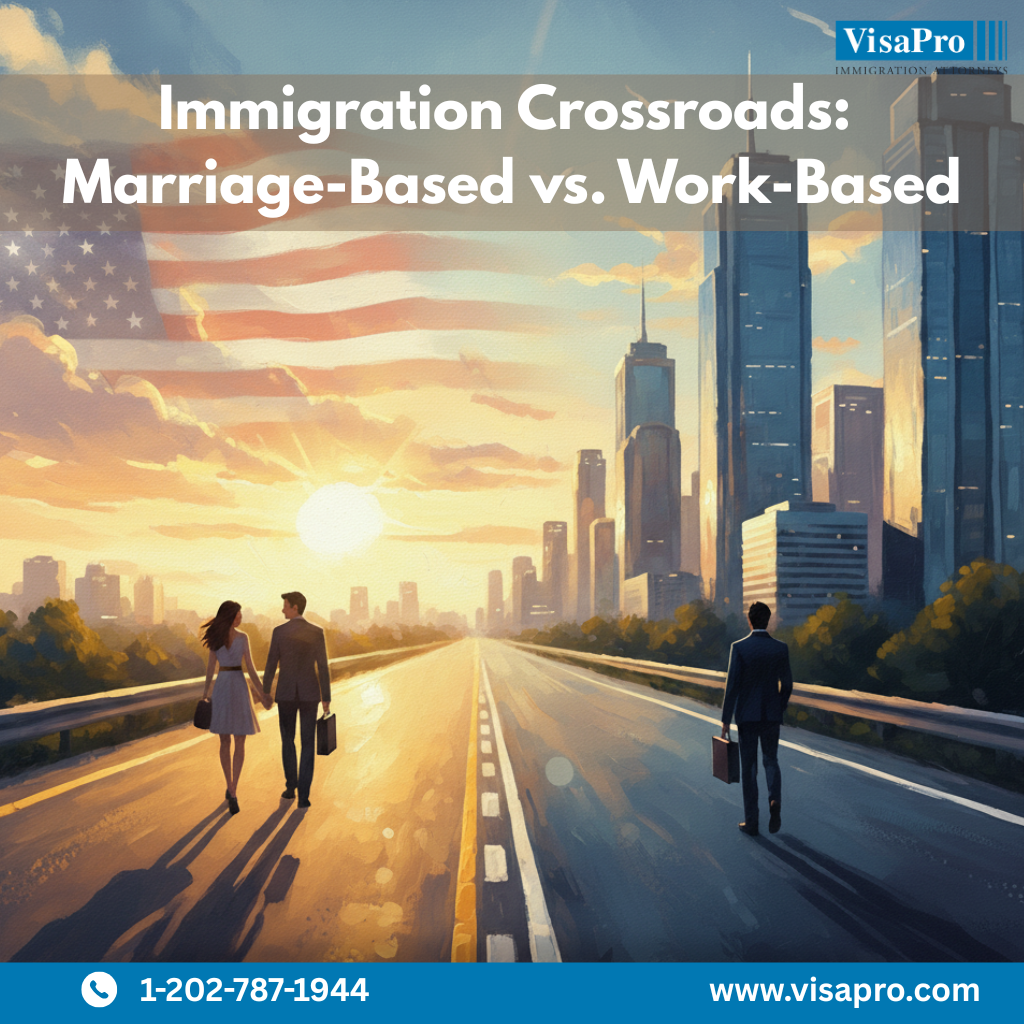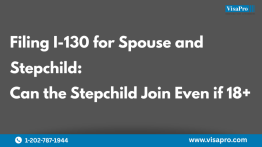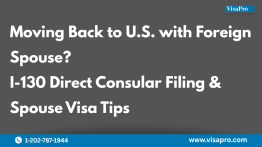Quick Summary:
If you are in the U.S., married or engaged to a U.S. citizen and your employer also pursuing an employment-based green card for you, you face a life-changing decision. Each path offers distinct advantages and challenges, from timeline differences to long-term implications. Understanding your options empowers you to make the choice that best serves your future and family goals.
Understanding Your Immigration Crossroads: Marriage vs. Employment Pathways
You may be standing at one of the most significant decision points in your immigration journey. Your employer has already initiated the PERM + I-140 process, demonstrating their commitment to your permanent residency. Simultaneously, your engagement or marriage to a U.S. citizen opens the door to permanent residency through an immediate relative Form I-130. The choice between the I-130 immediate relative petition and the PERM + I-140 employment route depends on timing, career goals, retrogression risks, and the type of green card you’d receive.
The decision between continuing with your employment-based petition or switching to a marriage-based application isn’t just about paperwork, it’s about your career stability, family planning, and long-term security. Each pathway carries unique timelines, requirements, and implications that extend far beyond the initial green card approval.
Understanding Your Options: Marriage-Based vs. Employment-Based Green Card
Marriage to a U.S. citizen allows you and your spouse to file an I-130 immediate relative petition and adjust status quickly, while the PERM/I-140 is a more involved and longer process and can be subject to visa backlogs. The right choice depends on your marriage plans, career stability, and green card goals.
When deciding between I-130 vs. I-140, you’re really comparing two fundamentally different paths to permanent residency:
- I-130 Immediate Relative Petition: as the spouse of a US citizen, you are an immediate relative, and your immigrant petition is not subject to any visa backlogs. This route generally offers the fastest path to a green card.
- PERM + I-140 Path: Employer-sponsored, requiring labor certification (PERM) and subject to visa bulletin backlogs, with significantly long backlogs for nationals of India and China.
For example:
- Scenario 1: Rohan, from India, was engaged to a U.S. citizen. His employer had already filed PERM. Because of visa retrogression, the I-140 route could take over 10 years. He decided to pursue the I-130/AOS route and obtained a green card in less than 1 year.
- Scenario 2: Laura from the U.K. had her PERM nearly certified when she got engaged. Since she wanted long-term career stability with her employer and wanted to obtain her green card through her own merits, she continued to pursue the I-140-based green card and obtained a lawful permanent residence in 2.5 years.

I-130 Immediate Relative Petition: Fast Track But With Conditions
The I-130 path for immediate relatives of US citizens petition offers one the of quickest and most direct paths to permanent residency. Unlike other family-based categories, immediate relatives face no annual numerical limitations, meaning no waiting in line due to per-country caps or preference category backlogs.
Your spouse can file Form I-130 immediately after marriage, and if you’re already in the United States, you can simultaneously file Form I-485 for adjustment of status. This concurrent filing often results in a total processing time of 6-15 months from filing to green card approval, depending on your field office’s workload.
Filing through marriage has clear advantages:
- No quota backlog for spouses of U.S. citizens.
- Simultaneous filing of I-130 + I-485 (Adjustment of Status) for those in valid status in the U.S.
- EAD and Advance Parole within 2-9 months.
- The immediate relative category also provides significant flexibility regarding your employment. Once you receive your Employment Authorization Document (EAD) through the I-485 process, you can change employers freely without jeopardizing your green card application. This freedom can be invaluable for career advancement and personal fulfillment.
Drawbacks
If your marriage is under two years old when USCIS approves your adjustment of status, you’ll receive a 2-year conditional green card. You must then file the Form I-751, Petition Remove Conditions on Residence jointly with your spouse shortly before your green card expires. While a minor inconvenience for most couples, the I-751 process is plagued by long processing times of over 18-24+ months. The process can also become a grueling ordeal for those whose marriages are in trouble, and those in abusive relationships.
PERM/I-140: The Employment-Based Foundation
The I-140 petition based on an approved PERM labor certification represents a substantial investment by your employer. The PERM process alone typically takes 12-24 months, followed by I-140 processing times that vary by preference category and premium processing elections.
If your I-140 is approved and your priority date becomes current, you’ll receive a 10-year unconditional green card immediately upon adjustment of status approval. This provides immediate stability without the need for condition removal procedures.
Employment-based petitions also offer certain protections through AC21 portability provisions. Once your I-485 has been pending for 180 days, you can change to a similar position with a different employer while maintaining your adjustment application. This flexibility, while not as broad as marriage-based options, still provides career mobility.
Employer sponsorship is often ideal for professionals who:
- Plan on remaining with their sponsoring employer.
- Prefer avoiding the 2-year conditional green cards.
- Already have PERM nearly approved or are pursuing fast-tracked green cards (EB-1A, EB-1B, EB-2/NIW or Schedule A)
Drawbacks
If you’re from countries with significant employment-based backlogs, such as India or China, it may take 5 to 15+ years to obtain the green card. While an approved I-140 allows individuals on H-1B to continue to extend their status beyond 6 years, those in other visa categories are not so lucky.
Consider Arjun’s experience:
Arjun’s PERM was approved just before his wedding to a US citizen. Since he was from India, his priority date was far backlogged. Although he eventually married and he and his spouse pursued the I-130/AOS process, he kept his I-140 process alive as a backup.
Timeline Analysis: Comparing Processing Speeds and Uncertainties
The timeline comparison between the I-130 v. I-140 processes reveal significant differences that often drive decision-making. Marriage-based I-130 petitions for immediate relatives typically process within 6-15 months from filing to green card receipt, assuming no complications or requests for additional evidence.
Employment-based timelines involving the PERM depend heavily on where you are in the PERM process. The entire PERM process can take anywhere from 12-24 months depending on the PERM processing time (which can fluctuate. I-140 processing adds another 4-8 months without premium processing, or 15 business days with premium processing. Adjustment of status then requires an additional 8-24 months, depending on field office backlogs.
However, timeline predictions must account for potential complications. Marriage-based cases may face additional scrutiny through interviews or requests for evidence to establish the bona fide nature of the relationship. Employment-based cases can encounter PERM audits, prevailing wage determinations, or recruitment requirement issues that significantly extend processing. On the other hand, the I-140 does allow for Premium Processing.
Priority date retrogression presents another timeline variable for employment-based cases. Even with an approved I-140, you cannot adjust status until your priority date becomes current according to the monthly Visa Bulletin. This can create indefinite waiting periods, particularly for applicants from oversubscribed countries.
The psychological impact of timeline uncertainty cannot be understated. Many couples find the predictability of marriage-based processing provides peace of mind that outweighs the conditional status requirement. Conversely, some individuals prefer maintaining control through their employment relationship rather than depending on their marriage status for immigration security.
Employer Relationships and Career Flexibility Considerations
Your relationship with your current employer plays a crucial role in this decision. Employers who invest in PERM processing demonstrate significant commitment to retaining your services. Abandoning this process might strain professional relationships, particularly if the employer has incurred substantial legal and filing fees.
However, the employment-based path creates a dependency relationship that extends throughout the green card process. You’ll need to maintain employment with the sponsoring employer through I-140 approval and potentially through adjustment of status completion, depending on timing and AC21 portability provisions.
Marriage-based petitions eliminate this employment dependency entirely. Once you receive work authorization through I-485 processing, you can pursue any career opportunities without immigration consequences. This freedom proves particularly valuable for entrepreneurs, career changers, or those seeking advancement opportunities with different employers.
Consider the practical implications: If your current employer experiences financial difficulties, layoffs, or business changes during PERM processing, your entire immigration case could be jeopardized. Marriage-based petitions provide insulation from these employment market uncertainties.
Why Many Choose To Keep Both Options Open
Filing both I-130 and I-140 allows flexibility, faster approvals, and backups in case of job loss or marital complications.
Many immigrants pursue a “dual strategy”:
- File I-130 through the U.S. citizen spouse.
- Continue the PERM/I-140 process for career backup.
This way, if the marriage faces issues, the I-140 provides security. If the job ends your relationship with your employer sours, the I-130 keeps you safe.
Making the Strategic Decision: Factors That Tip the Scale
The decision between I-130 immediate relative processing and continuing with I-140 PERM ultimately depends on your unique circumstances and priorities. Several factors typically prove decisive in this analysis.
If your employment-based case is significantly advanced, perhaps PERM is approved and I-140 is pending or approved, the sunk cost consideration becomes substantial. Abandoning a nearly complete process means forfeiting your employer’s investment and potentially facing longer overall timelines if marriage-based processing encounters complications.
Conversely, if PERM processing is still in early stages or has encountered complications like audit selections, switching to marriage-based processing might provide faster, more predictable results. Recent marriages to U.S. citizens create strong immediate relative eligibility that bypasses employment market dependencies.
Your country of birth significantly impacts this decision due to employment-based retrogression patterns. Applicants from India and China often benefit from marriage-based processing due to employment-based backlogs, while applicants from countries with current priority dates might prefer completing their employment-based cases.
Practical Tips Before Making Your Decision
Consult with an experienced immigration attorney to evaluate timing, risks, and strategies. Don’t abandon one path too quickly.
Practical suggestions:
- Don’t withdraw I-140 unless advised- keep it alive.
- Plan around marriage timing if you prefer a 10-year green card, i.e., don’t file the I-130 immediately after getting married
- Track the visa bulletin if relying on employment-based category.
- Document your marriage thoroughly if you file I-130.
Do’s and Don’ts:
- Do file both if possible.
- Do maintain honest, consistent documentation.
- Don’t assume conditional green cards are inferior.
- Don’t rely solely on employer sponsorship if unsure about job stability.
Conclusion: Making the Best Choice for Your Future
Choosing between I-130 immediate relative and I-140 PERM is a deeply personal decision. Both paths have strengths and trade-offs. Many find comfort in keeping both open, while some prefer the speed of I-130 or the stability of I-140.
VisaPro has helped thousands of individuals navigate this very crossroad, balancing love, career, and long-term immigration security. Schedule your strategy call today and let us guide you with confidence.
Frequently Asked Questions (FAQ)
1.What’s the main difference between marriage-based I-130 vs PERM + I-140 processing for someone in my situation?
The I-130 immediate relative process typically provides faster processing (6-15 months) but results in a conditional green card requiring future condition removal. The I-140 process takes longer overall but provides an unconditional 10-year green card immediately upon approval.
2.Can I pursue both the I-130 and I-140 processes simultaneously?
Yes, you can maintain both petitions simultaneously, though this requires careful coordination with experienced immigration counsel. Having both options provides flexibility to proceed with whichever case processes faster or encounters fewer complications.
3.How does the PERM + I-140 process timeline compare to immediate relative processing?
The PERM + I-140 process typically takes 18-36 months from PERM filing to green card receipt (for those from most countries except India and China), while immediate relative processing averages 8-15 months from I-130 filing to adjustment approval. However, employment-based cases avoid the conditional status period.
4.Will switching from employment-based to marriage-based processing damage my relationship with my employer?
This depends on your employer’s policies and the stage of your case. Open communication about your decision and willingness to continue contributing to the organization often maintains positive relationships. Some employers understand personal circumstances require flexibility in immigration planning.
5.What happens if my I-130 marriage-based case is denied after I abandon my I-140 process?
If your marriage-based case faces denial, you might lose the ability to restart your employment-based case from the same point. This risk emphasizes the importance of careful case evaluation and potentially maintaining both options until one reach completion.
6.Can I change employers after my I-140 is approved but before adjustment of status?
Yes, AC21 portability provisions allow job changes to similar positions after your I-485 has been pending for 180 days, provided your I-140 remains valid. This provides some career flexibility while maintaining your employment-based case.
7.How does country of birth affect the decision between I-130 immediate relative and I-140 processing?
Applicants from countries with significant employment-based backlogs (India, China) often benefit from immediate relative processing due to no numerical limitations. Applicants from countries with current priority dates might prefer employment-based processing for the unconditional green card benefit.
8.What documentation differences exist between marriage-based and employment-based green card applications?
Marriage-based cases require extensive documentation proving the bona fide nature of your relationship, including joint financial records, cohabitation evidence, and relationship history. Employment-based cases focus on educational credentials, work experience, and employer documentation through the PERM process.
Need help deciding between I-130 immediate relative and I-140 PERM processing?
VisaPro has guided thousands through the most complex immigration crossroads, protecting employment relationships, securing faster green card approvals, and avoiding costly strategic mistakes. Schedule your strategy call today.
What VisaPro Customers Are Saying
The US [B-1] Visa has always been a tough ride, and being denied a few times it makes it even worse. But thanks to VisaPro and their meticulous processing I was granted a Visa. I would like to thank you and all the people involved in making this a success. I would like to recommend VisaPro to all those who seek peace of mind and hassle free Visa processing.”




 Manas Bhat, Director Operations, First Houston Mortgage India
Manas Bhat, Director Operations, First Houston Mortgage India

